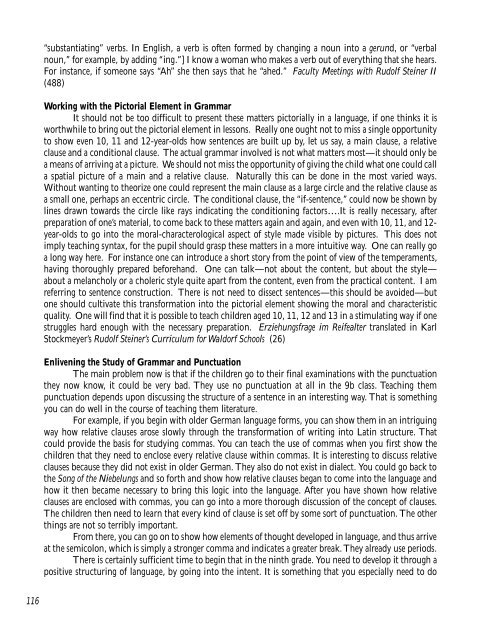Colloquium on English - Research Institute for Waldorf Education
Colloquium on English - Research Institute for Waldorf Education
Colloquium on English - Research Institute for Waldorf Education
Create successful ePaper yourself
Turn your PDF publications into a flip-book with our unique Google optimized e-Paper software.
116<br />
“substantiating” verbs. In <strong>English</strong>, a verb is often <strong>for</strong>med by changing a noun into a gerund, or “verbal<br />
noun,” <strong>for</strong> example, by adding “ing.”] I know a woman who makes a verb out of everything that she hears.<br />
For instance, if some<strong>on</strong>e says “Ah” she then says that he “ahed.” Faculty Meetings with Rudolf Steiner II<br />
(488)<br />
Working with the Pictorial Element in Grammar<br />
It should not be too difficult to present these matters pictorially in a language, if <strong>on</strong>e thinks it is<br />
worthwhile to bring out the pictorial element in less<strong>on</strong>s. Really <strong>on</strong>e ought not to miss a single opportunity<br />
to show even 10, 11 and 12-year-olds how sentences are built up by, let us say, a main clause, a relative<br />
clause and a c<strong>on</strong>diti<strong>on</strong>al clause. The actual grammar involved is not what matters most—it should <strong>on</strong>ly be<br />
a means of arriving at a picture. We should not miss the opportunity of giving the child what <strong>on</strong>e could call<br />
a spatial picture of a main and a relative clause. Naturally this can be d<strong>on</strong>e in the most varied ways.<br />
Without wanting to theorize <strong>on</strong>e could represent the main clause as a large circle and the relative clause as<br />
a small <strong>on</strong>e, perhaps an eccentric circle. The c<strong>on</strong>diti<strong>on</strong>al clause, the “if-sentence,” could now be shown by<br />
lines drawn towards the circle like rays indicating the c<strong>on</strong>diti<strong>on</strong>ing factors….It is really necessary, after<br />
preparati<strong>on</strong> of <strong>on</strong>e’s material, to come back to these matters again and again, and even with 10, 11, and 12year-olds<br />
to go into the moral-characterological aspect of style made visible by pictures. This does not<br />
imply teaching syntax, <strong>for</strong> the pupil should grasp these matters in a more intuitive way. One can really go<br />
a l<strong>on</strong>g way here. For instance <strong>on</strong>e can introduce a short story from the point of view of the temperaments,<br />
having thoroughly prepared be<strong>for</strong>ehand. One can talk—not about the c<strong>on</strong>tent, but about the style—<br />
about a melancholy or a choleric style quite apart from the c<strong>on</strong>tent, even from the practical c<strong>on</strong>tent. I am<br />
referring to sentence c<strong>on</strong>structi<strong>on</strong>. There is not need to dissect sentences—this should be avoided—but<br />
<strong>on</strong>e should cultivate this trans<strong>for</strong>mati<strong>on</strong> into the pictorial element showing the moral and characteristic<br />
quality. One will find that it is possible to teach children aged 10, 11, 12 and 13 in a stimulating way if <strong>on</strong>e<br />
struggles hard enough with the necessary preparati<strong>on</strong>. Erziehungsfrage im Reifealter translated in Karl<br />
Stockmeyer’s Rudolf Steiner’s Curriculum <strong>for</strong> <strong>Waldorf</strong> Schools (26)<br />
Enlivening the Study of Grammar and Punctuati<strong>on</strong><br />
The main problem now is that if the children go to their final examinati<strong>on</strong>s with the punctuati<strong>on</strong><br />
they now know, it could be very bad. They use no punctuati<strong>on</strong> at all in the 9b class. Teaching them<br />
punctuati<strong>on</strong> depends up<strong>on</strong> discussing the structure of a sentence in an interesting way. That is something<br />
you can do well in the course of teaching them literature.<br />
For example, if you begin with older German language <strong>for</strong>ms, you can show them in an intriguing<br />
way how relative clauses arose slowly through the trans<strong>for</strong>mati<strong>on</strong> of writing into Latin structure. That<br />
could provide the basis <strong>for</strong> studying commas. You can teach the use of commas when you first show the<br />
children that they need to enclose every relative clause within commas. It is interesting to discuss relative<br />
clauses because they did not exist in older German. They also do not exist in dialect. You could go back to<br />
the S<strong>on</strong>g of the Niebelungs and so <strong>for</strong>th and show how relative clauses began to come into the language and<br />
how it then became necessary to bring this logic into the language. After you have shown how relative<br />
clauses are enclosed with commas, you can go into a more thorough discussi<strong>on</strong> of the c<strong>on</strong>cept of clauses.<br />
The children then need to learn that every kind of clause is set off by some sort of punctuati<strong>on</strong>. The other<br />
things are not so terribly important.<br />
From there, you can go <strong>on</strong> to show how elements of thought developed in language, and thus arrive<br />
at the semicol<strong>on</strong>, which is simply a str<strong>on</strong>ger comma and indicates a greater break. They already use periods.<br />
There is certainly sufficient time to begin that in the ninth grade. You need to develop it through a<br />
positive structuring of language, by going into the intent. It is something that you especially need to do

















